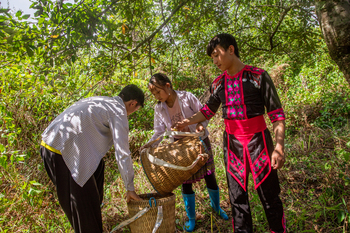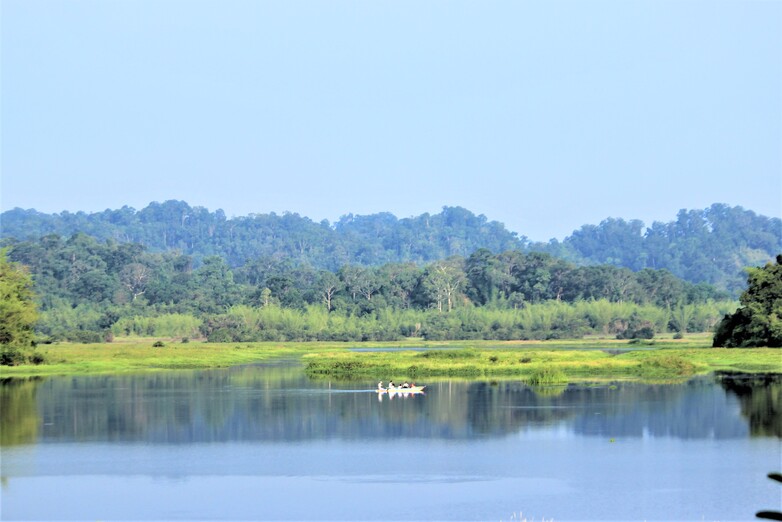Forest Biodiversity Programme
Project description
Title: Conservation and Sustainable Use of Forest Biodiversity and Ecosystem Services in Viet Nam
Commissioned by: German Federal Ministry for Economic Cooperation and Development (BMZ)
Country: Socialist Republic of Viet Nam
Lead executing agency: Ministry of Agriculture and Rural Development (MARD)
Overall term: 2014 to 2021

Context
Viet Nam is one of the world’s most significant biodiversity hotspots. The biodiversity and ecosystem services of forests play a vital role in the livelihoods of rural populations in Viet Nam, particularly the approximately 25 million people living in the proximity of forests. In addition, the biodiversity and ecosystem services of forests are the cornerstones for the agricultural, forestry and fishery sectors, and thus underpin national economic development. These services also play an important role when it comes to climate change adaptation and mitigation. Despite an overall increase of the forest cover in Viet Nam, the integrity and quality of forests has deteriorated over the last decades, and the forests’ biodiversity and ecosystem services are increasingly threatened.
Viet Nam has committed to several international forest and biodiversity conservation initiatives, including the Convention on Biological Diversity. Ever since the Forest Protection and Development Law and the Forestry Law came into force in 2004 and 2019 respectively, Viet Nam has been accelerating the process of forestry sector reform with the aim of balancing economic, environmental and social aspects in sector development. The Biodiversity Law, issued in 2008 also underpins the country’s efforts to prioritise biodiversity conservation in all sectors.
Objective
State administrative agencies at national and provincial level responsible for the management of protected forests implement mechanisms which provide benefits from biodiversity conservation and sustainable forest management to local communities.

Approach
The project focuses on the following three working areas:
1. Legal and policy framework. The project advises national and local decision makers to develop and improve legal frameworks, technical guidelines for biodiversity conservation and sustainable use of forest ecosystem services. The advice focuses on securing local people’s participation and enables them to and benefit from forest resources and revenues. This includes the broadening of the financing basis for forest owners through developing financing guidelines for protected forests and piloting new models for the Payment for Forest Environmental Services.
2. Sustainable management of protected areas. The project strengthens the management capacity of protected areas with respect to data and information management. This will provide the basis for eventually setting up sustainable financing strategies and sustainable forest management plans. One important aspect in this regard, which is further strengthened through project activities, is the participation of the adjacent communities. To ensure long-term financial stability for protected areas, the project also supports the integration of ecosystem services in provincial spatial plans.
3. Implementation and monitoring of FLEGT. The implementation of the Voluntary Partnership Agreement on Forest Law Enforcement, Governance and Trade (VPA FLEGT) is a joint commitment of Viet Nam and the European Union (EU) to work together to address illegal logging and associated trade. The project is supporting Viet Nam in fulfilling its commitments of the VPA FLEGT. The focus is on strengthening the capacity of non-state actors to contribute effectively to the implementation and monitoring of the agreement.
Results
- Improved Legal Framework: One crucial element of the revised Forestry Law adopted in November 2018 and its by-laws are the general obligation of forest owners to protect biodiversity. The new Law on Planning, adopted in December 2018, led to the mandatory consideration of ecosystem services in integrated planning. Through the support of the project these central regulations conducive to biodiversity conservation and sustainable use of ecosystems services have been pinned down in the national legislative framework of Viet Nam
- Enhancing forest financing: Payment for Forest Environmental Services (PFES) disbursed more than 126 million US dollars in 2018 with more than 500,000 forest owners or contracted households benefitting. Through the support of the project the use of bank-accounts has been piloted in three provinces to replace cash disbursements to forest owners, which improves transparency, efficiency, and reduces the risk related to cash transports over long distances. Almost 2,000 bank accounts have been opened for individual households and communities. An amount of 1.28 Million US dollars has been disbursed via these bank accounts. Encouraged by the good results of this disbursement mechanism the Viet Nam Administration of Forestry promulgated in October 2018 the Guidelines for the distribution of PFES funds via bank accounts to be implemented nationwide.
- Effective management of Protected Areas: The project was one of the most active promotors of the Spatial Monitoring and Reporting Tool (SMART) in Viet Nam. Between 2014 and 2017, ten out of eighteen SMART sites in Viet Nam were supported by the project. To support the accessibility and use of data, an Online Reporting System for protected areas has been introduced. Moreover, through the project’s advocacy work, Viet Nam issued two important policies for the improvement of protected area management and species conservation, namely the National Capacity Development Plan for protected area staff and the Urgent Primate Protection Plan.
- Progress towards timber legality: The EU and Viet Nam signed the Voluntary Partnership on Forest Law Enforcement Governance and Trade (VPA FLEGT) in October 2018. The project supported the development of the joint implementation framework for the VPA FLEGT as well as several preparatory studies. Results of the studies, such as the recognition of voluntary certification schemes, are now being taken up in the development of the regulatory framework to implement the VPA.
